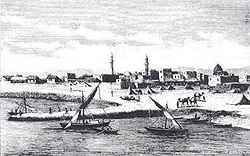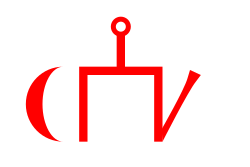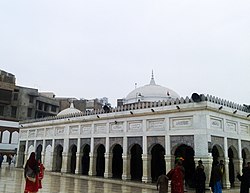Ibn Battuta
Ibn Battuta (1304 – 1368 or 1369) was a Moroccan explorer. He is known for the account of his journeys called the Rihla ("Voyage"). He travelled for nearly 30 years and covered most of the Islamic world. He also explored West Africa, Southern and Eastern Europe, South Asia, Central Asia, Southeast Asia and China. This distance was more than Marco Polo travelled; about 75,000 kilometres (47,000 mi). Ibn Battuta was considered the greatest traveller of the medieval period. Battuta also made maps that were used by cartographers. He also met Mohammad Bin Tughlaq and wrote a book called "The Travels Of Ibn Battutta". Ibn Battuta was born on February 24, 1304 in Tangier. His family consisted of judges and scholars of Islamic law. At age 21, Ibn Battuta started his long exploration when he went on the Hajj. This is a year-long pilgrimage that brings Muslims closer to God. Ibn Battuta first went across North Africa (Maghreb), to the great port Alexandria in 1326. Ibn Battuta spent 30 years visiting every Muslim country of his day. He recorded details about the social and political life he saw on his journeys.[1][2][3][4][5][6][7][8] He gave information all about Muhammad Bin Tuglaq.
Ibn Battuta met a Syrian Arab Damascene girl who was a slave of a black African governor in Mali. Ibn Battuta engaged in a conversation with her in Arabic. [9][10][11] The black man was a scholar of Islam and his name was Farba Sulayman. He was openly violating the rule in Islam against enslaving Arabs.[12][13]
Christians became part of harems as slaves in the Balkans and Asia Minor when the Turks invaded. Muslim qadis owned Christian slave girls. Greek girls who were pretty were forced into prostitution after being enslaved to Turks who took all their earnings in the 14th century according to Ibn Battuta.[14]
Ibn Battuta Media
Old City of Sana'a, Yemen
The port and waterfront of Zeila
The Great Mosque of Kilwa Kisiwani, made of coral stones, is the largest Mosque of its kind.
Ibn Battuta may have met Andronikos III Palaiologos in late 1332.
Bactrian camel (one of the symbols of Silk Road caravans) in front of Mausoleum of Khoja Ahmed Yasawi in the city of Turkestan, Kazakhstan
Flag of the Golden Horde during the reign of Öz Beg Khan
Tomb of Feroze Shah Tughluq, successor of Muhammad bin Tughluq in Delhi. Ibn Battuta served as a qadi or judge for six years during Muhammad bin Tughluq's reign.
Ibn Battuta in 1334 visited the shrine of Baba Farid in Pakpattan.
Notes
- ↑ Madelung, Wilferd. "Ibn Battuta." World Book Advanced. World Book, 2013. Web. 4 Dec. 2013. APA:
- ↑ Fritze, Ronald. "Ibn Battuta." World History: Ancient and Medieval Eras. ABC-CLIO, 2013. Web. 4 Dec. 2013.
- ↑ "Abu Abdallah Ibn Battuta." Explorers & Discoverers of the World. Gale, 1993.Biography in Context. Web. 4 Dec. 2013. Levinson, David. "Ibn Battuta." Encyclopedia of Modern Asia. Ed. Karen Christensen and David Levinson. New York: Charles Scribner's Sons, 2003. Biography in Context. Web. 4 Dec. 2013.
- ↑ Ibn Batuta (1958). The Travels of Ibn Baṭṭūṭa: A.D. 1325-1354. Published for the Hakluyt Society at the University Press. p. 136. ISBN 0904180670.
A.D. 1325-1354 Ibn Batuta ... in the Maldives IV , 836 rescued in shipwreck IV ' , 815 , 857 travelling with Ibn Battuta IV , 814 Zad al - Mäl May Wealth Increase ' , name of a slave girl at ... al - Khalil I , 230–31 , 240–41 stationers at Damascus I , 131 Stoning , The I , 246–7 strangulation III , 565 Suadiva ( Maldives district ) IV .
- ↑ Guthrie, Shirley (2001). Arab Women in the Middle Ages: Private Lives and Public Roles. Saqi. pp. 184, 205. ISBN 0863567738.
Ibn Battuta described the large number of private bathrooms with a corner washbasin and hot and cold taps in a hammam in Baghdad . ... arrangement ' , although apparently in Damascus anything from six to ten towels were used as the bather had successive treatments . ... This may have been fairly lucrative , since the criminal in question was accompanied by her young slave girl as far as the home ...
- ↑ The Clique, Part 3. The Clique. 1968. p. 39.
Cru . sades Ibn Battuta , Travels in Asia and Africa Ibn Jumair , Travels of Ibn Muhammad , Tamerlane or Timur , TT . Sanders Ibn Sa'id ... 7 Mendelsohn , Slavery in Anc . Near East Mill , Education , 1931 Miller , Henry Cabot Lodge , Biog .
- ↑ Pakistan Journal of Women's Studies, Volume 6, Issues 1-2. University of Karachi. 1999. p. 25.
robe of a man and never veiled , and - as the traveller Ibn Battutah reports- rode an elephant in sight of public and led the wars against rebels . ... Formerly she was a slave girl in the harem of the ' Abbasid ... 212 When Turan Shah received his stepmother's secret message about his father's death he went to Damascus to be ...
- ↑ Freeman-Grenville, Greville Stewart Parker; Kessel, Lorraine (1993). Historical Atlas of the Middle East (illustrated ed.). Simon & Schuster. p. 68. ISBN 0133909158.
- ↑ King, Noel Quinton (1971). Christian and Muslim in Africa. Harper & Row. p. 22. ISBN 0060647094.
... for the Farba understood Arabic and had an Arabic - speaking secretary and even a slave girl from Damascus . ... Eventually Ibn Battuta crossed the Niger ( he calls it the Nile ) and went on to the capital of the king of the Blacks ( Mali ) .
- ↑ Fisher, Humphrey J.; Fisher, Allan G. B. (2001). Slavery in the History of Muslim Black Africa (illustrated, revised ed.). NYU Press. p. 182. ISBN 0814727166.
Ibn Battuta , visiting Mali in the 1350s , found a black town governor , a pilgrim , who surprised him by understanding some Arabic ; he discovered that the governor had in his household a young slave girl , a Damascus Arab . 12 The demand ...
- ↑ Hamel, Chouki El (2014). Black Morocco: A History of Slavery, Race, and Islam. Vol. 123 of African Studies. Cambridge University Press. p. 129. ISBN 978-1139620048.
Ibn Battuta reported that king Sulayman had about three hundred slaves and that they assembled whenever the king gave a ... who offered Ibn Battuta a slave boy, he noticed that the governor had an Arab slave girl from Damascus who spoke ...
- ↑ Tolmacheva, Marina A. (2017). "8 Concubines on the Road: Ibn Battuta's Slave Women". In Gordon, Matthew; Hain, Kathryn A. (eds.). Concubines and Courtesans: Women and Slavery in Islamic History (illustrated ed.). Oxford University Press. p. 170. ISBN 978-0190622183.
For his part, Ibn Battuta, who had been driven by vanity and curiosity to seek ownership of an educated female, parted ... of religion took place in large cultural centers such as Cairo and Damascus.90 If awarded certificates, such slaves could ...
- ↑ Harrington, Helise (1971). Adler, Bill; David, Jay; Harrington, Helise (eds.). Growing Up African. Morrow. p. 49.
A slave - girl of his joined us ; she was an Arab girl , of Damascus , and she spoke to me in Arabic . While this was going on we ... He died at Timbuktu in 1346 . 1 6 FROM " The Story of Rashid bin Hassani " THE TRAVELS OF IBN BATTUTA 49.
- ↑ Constantelos (Kōnstantelos), Demetrios J. (Dēmētrios I.) (1992). Poverty, Society, and Philanthropy in the Late Mediaeval Greek World. Vol. 2 of Studies in the social & religious history of the mediaeval Greek world. A.D. Caratzas. p. 107. ISBN 0892414014.
The Arab historian Ibn Battuta relates that in the fourteenth century the Turks bought beautiful Greek slave girls and forced them to become prostitutes ; each girl had to pay a regular sum to her master . Even the gadi , Muslim judge , owned
| Wikimedia Commons has media related to Lua error in Module:Commons_link at line 62: attempt to index field 'wikibase' (a nil value).. |








